Leadership and Management in Business: A Tesco Case Study Report
VerifiedAdded on 2021/02/21
|32
|3296
|134
Report
AI Summary
This report delves into the core concepts of leadership and management, examining the distinct roles and characteristics of leaders and managers within the context of Tesco Plc. The assignment explores how these roles apply in diverse situational contexts, such as enhancing brand image and reducing employee turnover. It further analyzes and applies various leadership theories and models, including situational leadership, systems leadership, and contingency leadership, providing a comprehensive understanding of their applications. The report also assesses the impact of the business environment on operational management and decision-making, offering a holistic view of leadership and management practices within a real-world business setting. The report provides a detailed analysis of the different theories and models of leadership, which can be implemented within a business as per the situation prevailing at that time.
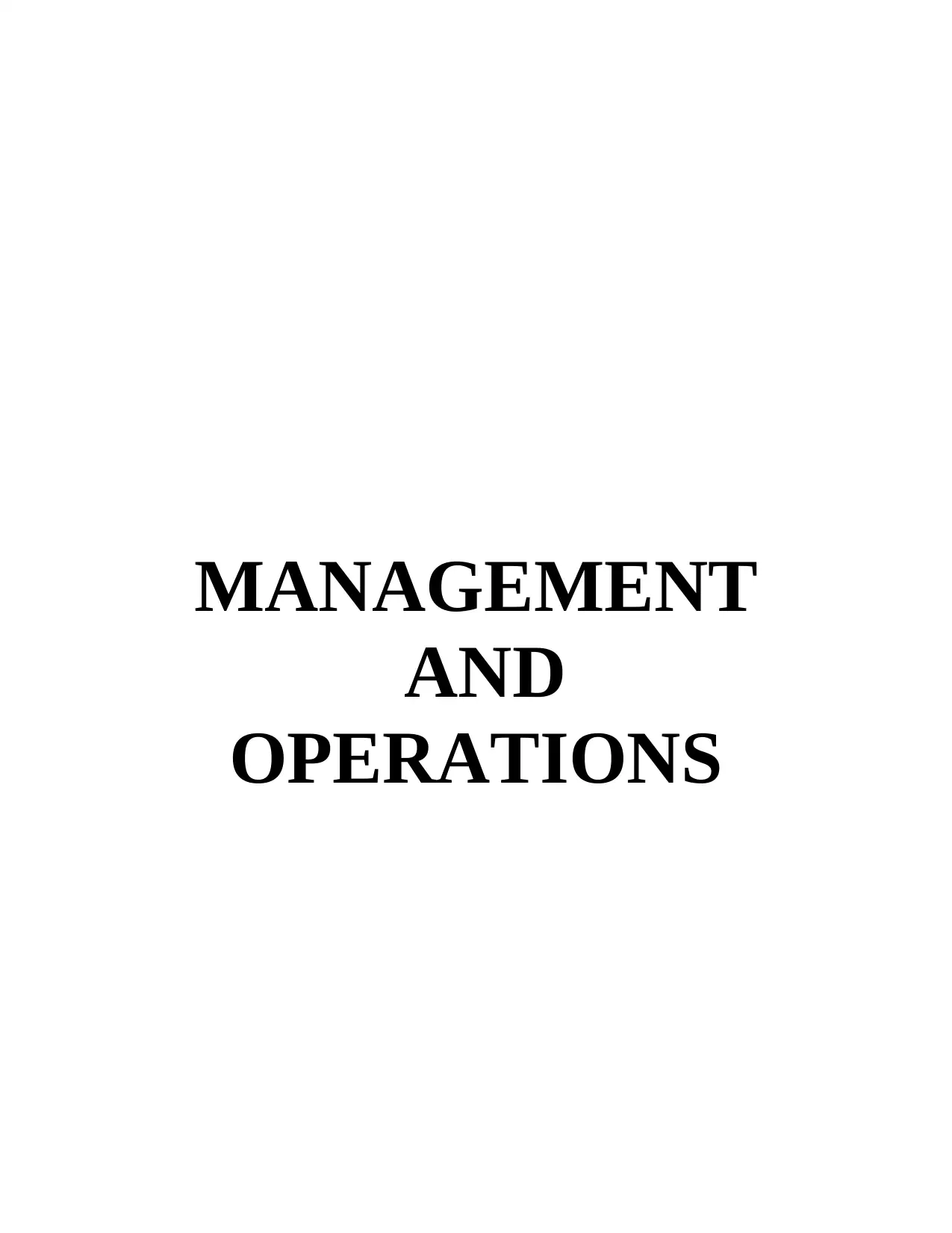
MANAGEMENT
AND
OPERATIONS
AND
OPERATIONS
Paraphrase This Document
Need a fresh take? Get an instant paraphrase of this document with our AI Paraphraser
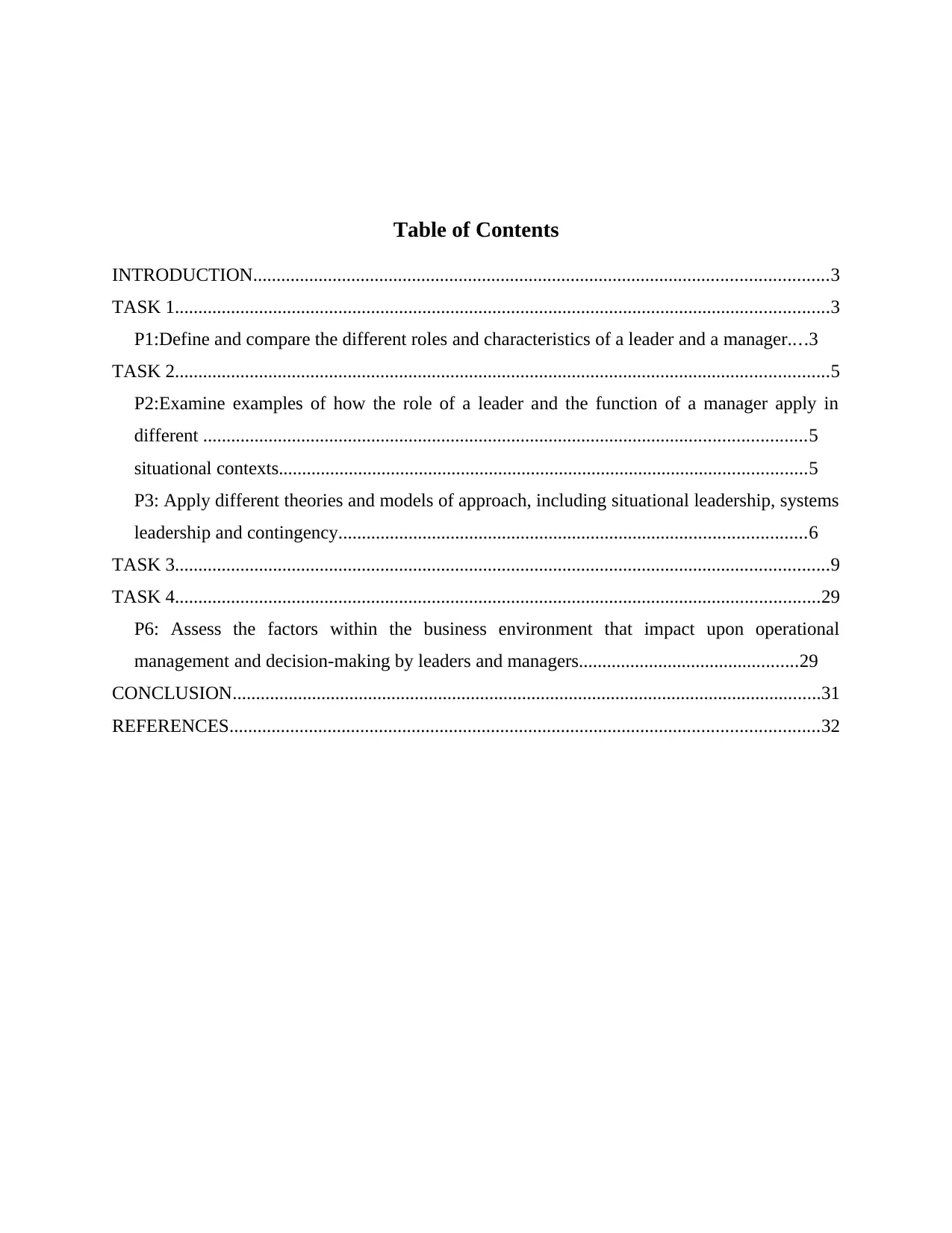
Table of Contents
INTRODUCTION...........................................................................................................................3
TASK 1............................................................................................................................................3
P1:Define and compare the different roles and characteristics of a leader and a manager....3
TASK 2............................................................................................................................................5
P2:Examine examples of how the role of a leader and the function of a manager apply in
different .................................................................................................................................5
situational contexts.................................................................................................................5
P3: Apply different theories and models of approach, including situational leadership, systems
leadership and contingency....................................................................................................6
TASK 3............................................................................................................................................9
TASK 4..........................................................................................................................................29
P6: Assess the factors within the business environment that impact upon operational
management and decision-making by leaders and managers...............................................29
CONCLUSION..............................................................................................................................31
REFERENCES..............................................................................................................................32
INTRODUCTION...........................................................................................................................3
TASK 1............................................................................................................................................3
P1:Define and compare the different roles and characteristics of a leader and a manager....3
TASK 2............................................................................................................................................5
P2:Examine examples of how the role of a leader and the function of a manager apply in
different .................................................................................................................................5
situational contexts.................................................................................................................5
P3: Apply different theories and models of approach, including situational leadership, systems
leadership and contingency....................................................................................................6
TASK 3............................................................................................................................................9
TASK 4..........................................................................................................................................29
P6: Assess the factors within the business environment that impact upon operational
management and decision-making by leaders and managers...............................................29
CONCLUSION..............................................................................................................................31
REFERENCES..............................................................................................................................32

INTRODUCTION
Management and operations are the process which are associated with the management
and controlling of all the activities and operations which are carried out within the association.
This procedure within the business is prime as it mainly focuses on the maximisation of the
profits. In this present assignment the concept of operation management is coined as the process
of managing the all the information, human resource of the business so that the working of the
business can be carried out in the most hard-hitting mode. The chosen association within this
report is Tesco Plc. Trading which is one of the leading retail company of the groceries. This
report focuses on the understanding of various function and characteristic of the leaders and
managers with the aid of the specific example. Along with this, the study also covers different
models and theories related to the leadership and management. In addition to this the project will
also include various concepts which are associated to management and operations, leaders as
well as the managers. Furthermore, the study also covers various key factors related to business
environment and their impact on the decision making procedure of the leaders and the managers
within the association(Baboli And et. al., 2014).
TASK 1
P1:Define and compare the different roles and characteristics of a leader and a manager.
Leaders: A leader is considered to be as the person who is having the ability to influence
other to work for the achievement of the association goals within the time periods with all
required skills and tactics. Along with this a leaders is also coined as the person holding a
superior position within the business and is able to implement control over the associations
operations and people so that the vision of the firm can be achieved in an effective
manner(Nakamura and et. al., 2015).
Manager : A managers is referred to as the person who is responsible for the carrying
out and managing the activities within the association. Apart from this a manager can also
manage the departments within the business and can also provide guidance to the workers to
work for them(Saucedo-Martínez and et. al., 2018).
Management and operations are the process which are associated with the management
and controlling of all the activities and operations which are carried out within the association.
This procedure within the business is prime as it mainly focuses on the maximisation of the
profits. In this present assignment the concept of operation management is coined as the process
of managing the all the information, human resource of the business so that the working of the
business can be carried out in the most hard-hitting mode. The chosen association within this
report is Tesco Plc. Trading which is one of the leading retail company of the groceries. This
report focuses on the understanding of various function and characteristic of the leaders and
managers with the aid of the specific example. Along with this, the study also covers different
models and theories related to the leadership and management. In addition to this the project will
also include various concepts which are associated to management and operations, leaders as
well as the managers. Furthermore, the study also covers various key factors related to business
environment and their impact on the decision making procedure of the leaders and the managers
within the association(Baboli And et. al., 2014).
TASK 1
P1:Define and compare the different roles and characteristics of a leader and a manager.
Leaders: A leader is considered to be as the person who is having the ability to influence
other to work for the achievement of the association goals within the time periods with all
required skills and tactics. Along with this a leaders is also coined as the person holding a
superior position within the business and is able to implement control over the associations
operations and people so that the vision of the firm can be achieved in an effective
manner(Nakamura and et. al., 2015).
Manager : A managers is referred to as the person who is responsible for the carrying
out and managing the activities within the association. Apart from this a manager can also
manage the departments within the business and can also provide guidance to the workers to
work for them(Saucedo-Martínez and et. al., 2018).
⊘ This is a preview!⊘
Do you want full access?
Subscribe today to unlock all pages.

Trusted by 1+ million students worldwide
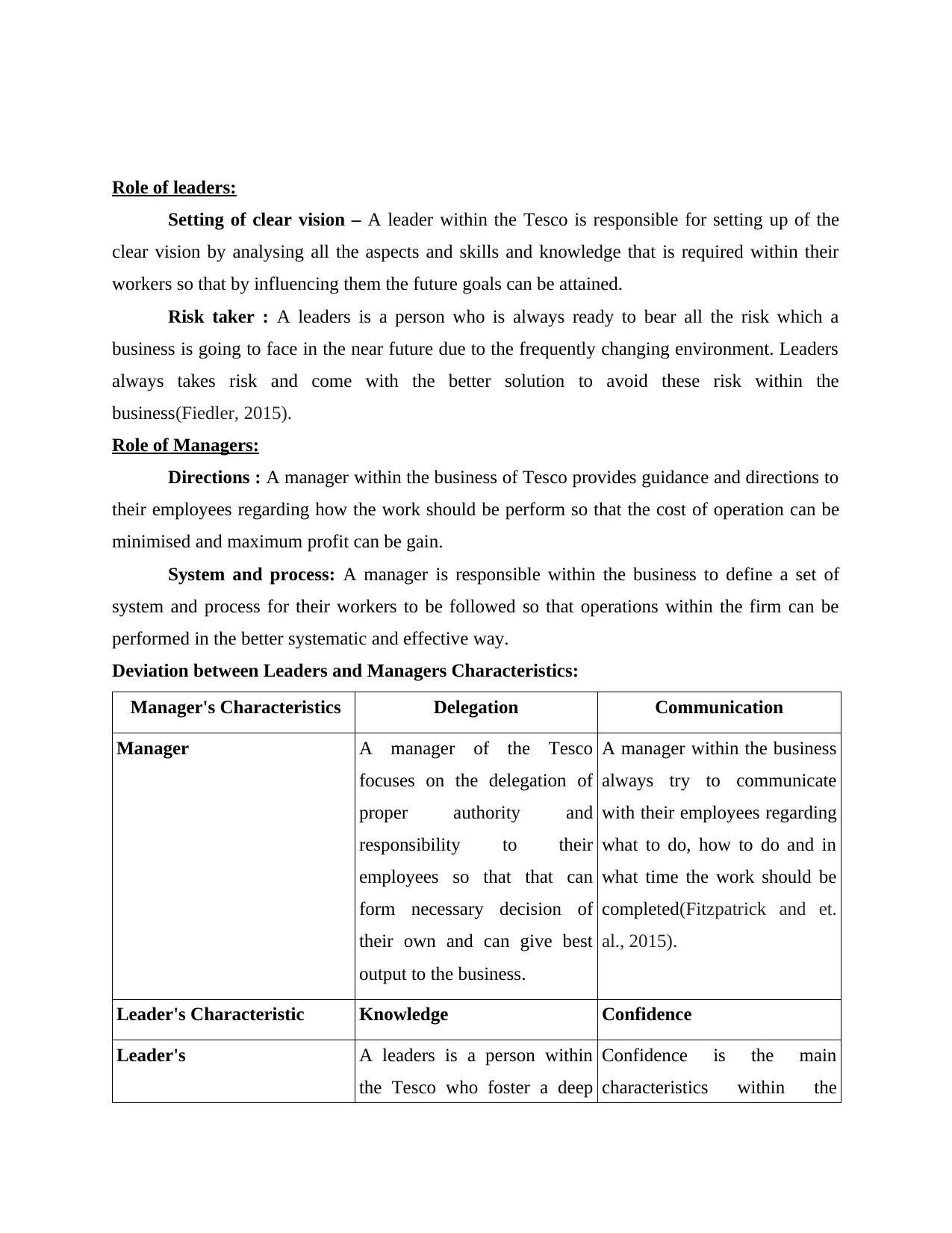
Role of leaders:
Setting of clear vision – A leader within the Tesco is responsible for setting up of the
clear vision by analysing all the aspects and skills and knowledge that is required within their
workers so that by influencing them the future goals can be attained.
Risk taker : A leaders is a person who is always ready to bear all the risk which a
business is going to face in the near future due to the frequently changing environment. Leaders
always takes risk and come with the better solution to avoid these risk within the
business(Fiedler, 2015).
Role of Managers:
Directions : A manager within the business of Tesco provides guidance and directions to
their employees regarding how the work should be perform so that the cost of operation can be
minimised and maximum profit can be gain.
System and process: A manager is responsible within the business to define a set of
system and process for their workers to be followed so that operations within the firm can be
performed in the better systematic and effective way.
Deviation between Leaders and Managers Characteristics:
Manager's Characteristics Delegation Communication
Manager A manager of the Tesco
focuses on the delegation of
proper authority and
responsibility to their
employees so that that can
form necessary decision of
their own and can give best
output to the business.
A manager within the business
always try to communicate
with their employees regarding
what to do, how to do and in
what time the work should be
completed(Fitzpatrick and et.
al., 2015).
Leader's Characteristic Knowledge Confidence
Leader's A leaders is a person within
the Tesco who foster a deep
Confidence is the main
characteristics within the
Setting of clear vision – A leader within the Tesco is responsible for setting up of the
clear vision by analysing all the aspects and skills and knowledge that is required within their
workers so that by influencing them the future goals can be attained.
Risk taker : A leaders is a person who is always ready to bear all the risk which a
business is going to face in the near future due to the frequently changing environment. Leaders
always takes risk and come with the better solution to avoid these risk within the
business(Fiedler, 2015).
Role of Managers:
Directions : A manager within the business of Tesco provides guidance and directions to
their employees regarding how the work should be perform so that the cost of operation can be
minimised and maximum profit can be gain.
System and process: A manager is responsible within the business to define a set of
system and process for their workers to be followed so that operations within the firm can be
performed in the better systematic and effective way.
Deviation between Leaders and Managers Characteristics:
Manager's Characteristics Delegation Communication
Manager A manager of the Tesco
focuses on the delegation of
proper authority and
responsibility to their
employees so that that can
form necessary decision of
their own and can give best
output to the business.
A manager within the business
always try to communicate
with their employees regarding
what to do, how to do and in
what time the work should be
completed(Fitzpatrick and et.
al., 2015).
Leader's Characteristic Knowledge Confidence
Leader's A leaders is a person within
the Tesco who foster a deep
Confidence is the main
characteristics within the
Paraphrase This Document
Need a fresh take? Get an instant paraphrase of this document with our AI Paraphraser
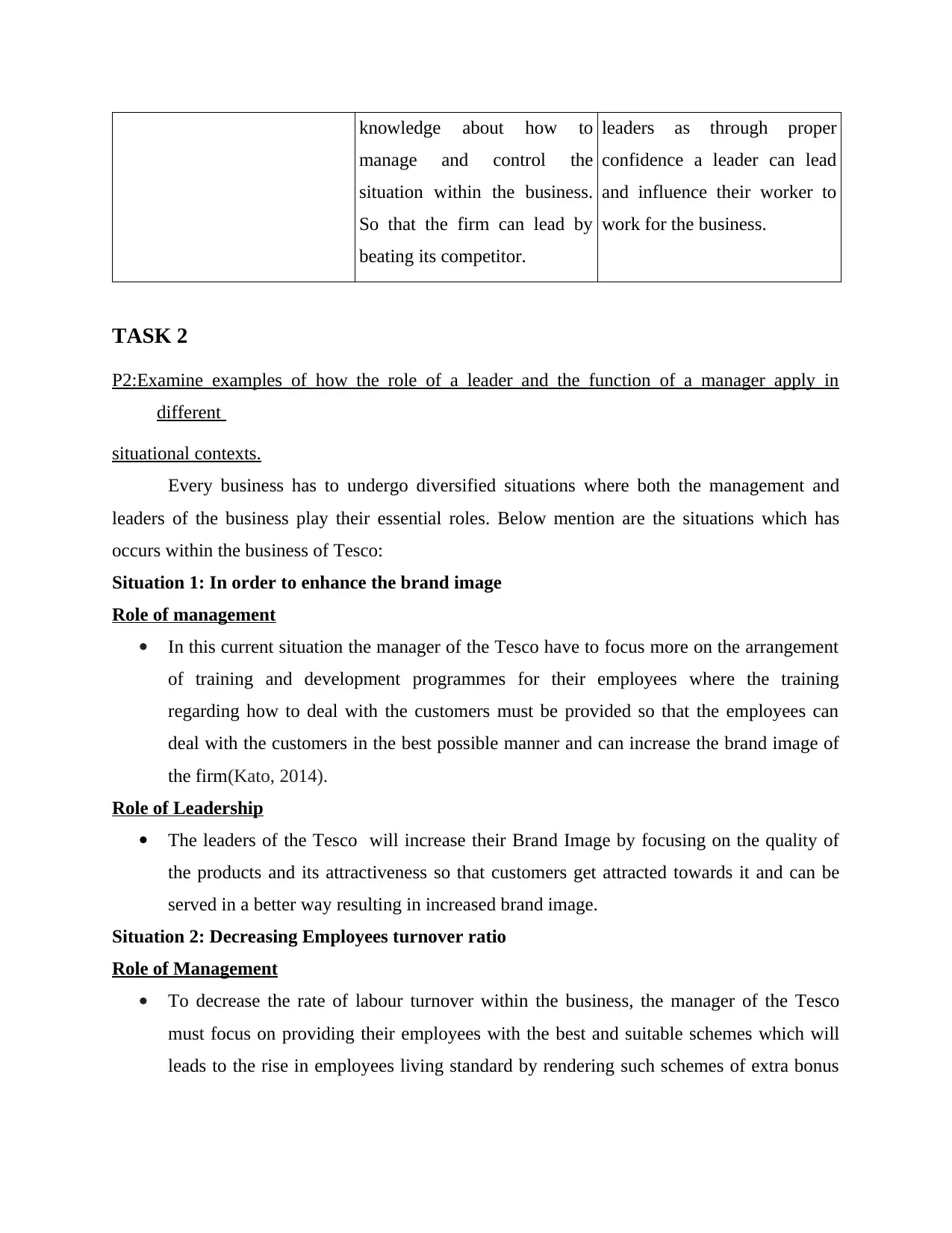
knowledge about how to
manage and control the
situation within the business.
So that the firm can lead by
beating its competitor.
leaders as through proper
confidence a leader can lead
and influence their worker to
work for the business.
TASK 2
P2:Examine examples of how the role of a leader and the function of a manager apply in
different
situational contexts.
Every business has to undergo diversified situations where both the management and
leaders of the business play their essential roles. Below mention are the situations which has
occurs within the business of Tesco:
Situation 1: In order to enhance the brand image
Role of management
In this current situation the manager of the Tesco have to focus more on the arrangement
of training and development programmes for their employees where the training
regarding how to deal with the customers must be provided so that the employees can
deal with the customers in the best possible manner and can increase the brand image of
the firm(Kato, 2014).
Role of Leadership
The leaders of the Tesco will increase their Brand Image by focusing on the quality of
the products and its attractiveness so that customers get attracted towards it and can be
served in a better way resulting in increased brand image.
Situation 2: Decreasing Employees turnover ratio
Role of Management
To decrease the rate of labour turnover within the business, the manager of the Tesco
must focus on providing their employees with the best and suitable schemes which will
leads to the rise in employees living standard by rendering such schemes of extra bonus
manage and control the
situation within the business.
So that the firm can lead by
beating its competitor.
leaders as through proper
confidence a leader can lead
and influence their worker to
work for the business.
TASK 2
P2:Examine examples of how the role of a leader and the function of a manager apply in
different
situational contexts.
Every business has to undergo diversified situations where both the management and
leaders of the business play their essential roles. Below mention are the situations which has
occurs within the business of Tesco:
Situation 1: In order to enhance the brand image
Role of management
In this current situation the manager of the Tesco have to focus more on the arrangement
of training and development programmes for their employees where the training
regarding how to deal with the customers must be provided so that the employees can
deal with the customers in the best possible manner and can increase the brand image of
the firm(Kato, 2014).
Role of Leadership
The leaders of the Tesco will increase their Brand Image by focusing on the quality of
the products and its attractiveness so that customers get attracted towards it and can be
served in a better way resulting in increased brand image.
Situation 2: Decreasing Employees turnover ratio
Role of Management
To decrease the rate of labour turnover within the business, the manager of the Tesco
must focus on providing their employees with the best and suitable schemes which will
leads to the rise in employees living standard by rendering such schemes of extra bonus

and compensation, rewards the business can easily sustain their employees within the
firm for long lasting period of time(Nakamura and et. al., 2015).
Role of Leadership
To retain the employees within the business the leaders of Tesco must focus on the
arrangement of effective programmes for their employees regarding the learning of new
procedures and changes so that they can easily cope up with the situation which is
changing frequently so that they can easily sustain in the working environment resulting
decreased rate of labour turnover.
All these above mentioned are the different situation which a business of Tesco is going through
and to manage and control these circumstances role of management and leadership are also writ
tern so that these situation can be controlled and firm productivity can be increased(Kato, 2015).
P3: Apply different theories and models of approach, including situational leadership, systems
leadership and contingency.
There are numbers of Models and Approaches of the Leadership which can be
implemented within a business as per the situation prevailing at that time. Some of these theories
ad model of approaches are as mentioned beneath:
Situational leadership theory : This theory of leadership is mainly concerned with the
requirement of the leadership style at that particular situation. This states that the most suitable
leaders is the one who leads the situation that has occur automatically. This is also known as the
model of choice where there is no pre decided approach of leadership to lead at the specific
situation.
History of situational leadership theory: This theory was developed by Blanchard and
Hersey in the year 1969, later on the theory was termed as “ Life cycle theory of the leadership”.
And in the year 1970s this leadership theory was again figured as the situational theory of the
leadership.
Example of situational leadership : In order to understand this lets consider a situation.
Suppose an infant is learning how to walk then here his parents will teach and support the infant
by guiding him how to take steps but later on as he grow they will keep on monitoring his step
and let the infant to walk by themselves and choosing their own pathways. Same In order to
carry the work within the business in a effective manner a leaders needs to motivate and provide
firm for long lasting period of time(Nakamura and et. al., 2015).
Role of Leadership
To retain the employees within the business the leaders of Tesco must focus on the
arrangement of effective programmes for their employees regarding the learning of new
procedures and changes so that they can easily cope up with the situation which is
changing frequently so that they can easily sustain in the working environment resulting
decreased rate of labour turnover.
All these above mentioned are the different situation which a business of Tesco is going through
and to manage and control these circumstances role of management and leadership are also writ
tern so that these situation can be controlled and firm productivity can be increased(Kato, 2015).
P3: Apply different theories and models of approach, including situational leadership, systems
leadership and contingency.
There are numbers of Models and Approaches of the Leadership which can be
implemented within a business as per the situation prevailing at that time. Some of these theories
ad model of approaches are as mentioned beneath:
Situational leadership theory : This theory of leadership is mainly concerned with the
requirement of the leadership style at that particular situation. This states that the most suitable
leaders is the one who leads the situation that has occur automatically. This is also known as the
model of choice where there is no pre decided approach of leadership to lead at the specific
situation.
History of situational leadership theory: This theory was developed by Blanchard and
Hersey in the year 1969, later on the theory was termed as “ Life cycle theory of the leadership”.
And in the year 1970s this leadership theory was again figured as the situational theory of the
leadership.
Example of situational leadership : In order to understand this lets consider a situation.
Suppose an infant is learning how to walk then here his parents will teach and support the infant
by guiding him how to take steps but later on as he grow they will keep on monitoring his step
and let the infant to walk by themselves and choosing their own pathways. Same In order to
carry the work within the business in a effective manner a leaders needs to motivate and provide
⊘ This is a preview!⊘
Do you want full access?
Subscribe today to unlock all pages.

Trusted by 1+ million students worldwide
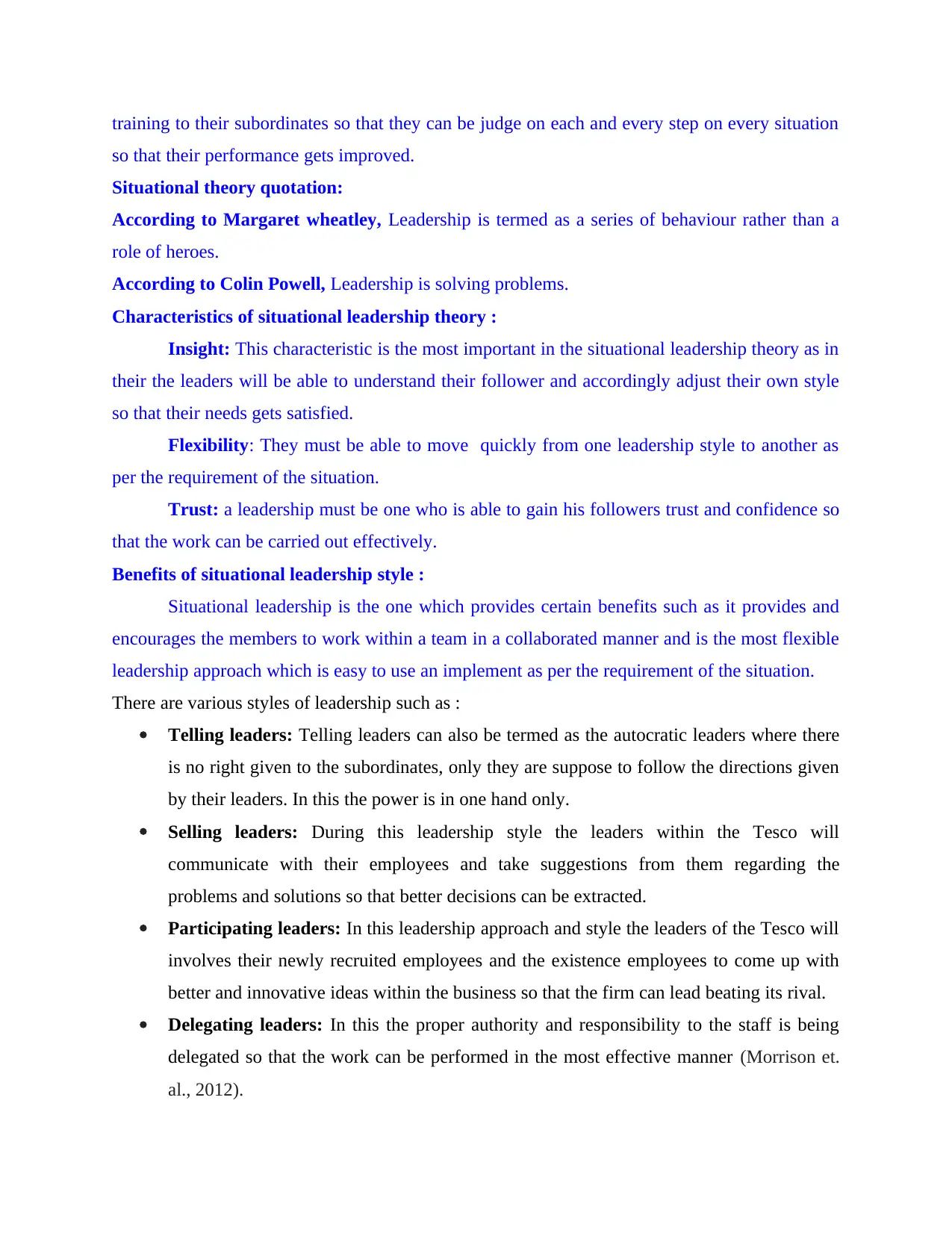
training to their subordinates so that they can be judge on each and every step on every situation
so that their performance gets improved.
Situational theory quotation:
According to Margaret wheatley, Leadership is termed as a series of behaviour rather than a
role of heroes.
According to Colin Powell, Leadership is solving problems.
Characteristics of situational leadership theory :
Insight: This characteristic is the most important in the situational leadership theory as in
their the leaders will be able to understand their follower and accordingly adjust their own style
so that their needs gets satisfied.
Flexibility: They must be able to move quickly from one leadership style to another as
per the requirement of the situation.
Trust: a leadership must be one who is able to gain his followers trust and confidence so
that the work can be carried out effectively.
Benefits of situational leadership style :
Situational leadership is the one which provides certain benefits such as it provides and
encourages the members to work within a team in a collaborated manner and is the most flexible
leadership approach which is easy to use an implement as per the requirement of the situation.
There are various styles of leadership such as :
Telling leaders: Telling leaders can also be termed as the autocratic leaders where there
is no right given to the subordinates, only they are suppose to follow the directions given
by their leaders. In this the power is in one hand only.
Selling leaders: During this leadership style the leaders within the Tesco will
communicate with their employees and take suggestions from them regarding the
problems and solutions so that better decisions can be extracted.
Participating leaders: In this leadership approach and style the leaders of the Tesco will
involves their newly recruited employees and the existence employees to come up with
better and innovative ideas within the business so that the firm can lead beating its rival.
Delegating leaders: In this the proper authority and responsibility to the staff is being
delegated so that the work can be performed in the most effective manner (Morrison et.
al., 2012).
so that their performance gets improved.
Situational theory quotation:
According to Margaret wheatley, Leadership is termed as a series of behaviour rather than a
role of heroes.
According to Colin Powell, Leadership is solving problems.
Characteristics of situational leadership theory :
Insight: This characteristic is the most important in the situational leadership theory as in
their the leaders will be able to understand their follower and accordingly adjust their own style
so that their needs gets satisfied.
Flexibility: They must be able to move quickly from one leadership style to another as
per the requirement of the situation.
Trust: a leadership must be one who is able to gain his followers trust and confidence so
that the work can be carried out effectively.
Benefits of situational leadership style :
Situational leadership is the one which provides certain benefits such as it provides and
encourages the members to work within a team in a collaborated manner and is the most flexible
leadership approach which is easy to use an implement as per the requirement of the situation.
There are various styles of leadership such as :
Telling leaders: Telling leaders can also be termed as the autocratic leaders where there
is no right given to the subordinates, only they are suppose to follow the directions given
by their leaders. In this the power is in one hand only.
Selling leaders: During this leadership style the leaders within the Tesco will
communicate with their employees and take suggestions from them regarding the
problems and solutions so that better decisions can be extracted.
Participating leaders: In this leadership approach and style the leaders of the Tesco will
involves their newly recruited employees and the existence employees to come up with
better and innovative ideas within the business so that the firm can lead beating its rival.
Delegating leaders: In this the proper authority and responsibility to the staff is being
delegated so that the work can be performed in the most effective manner (Morrison et.
al., 2012).
Paraphrase This Document
Need a fresh take? Get an instant paraphrase of this document with our AI Paraphraser
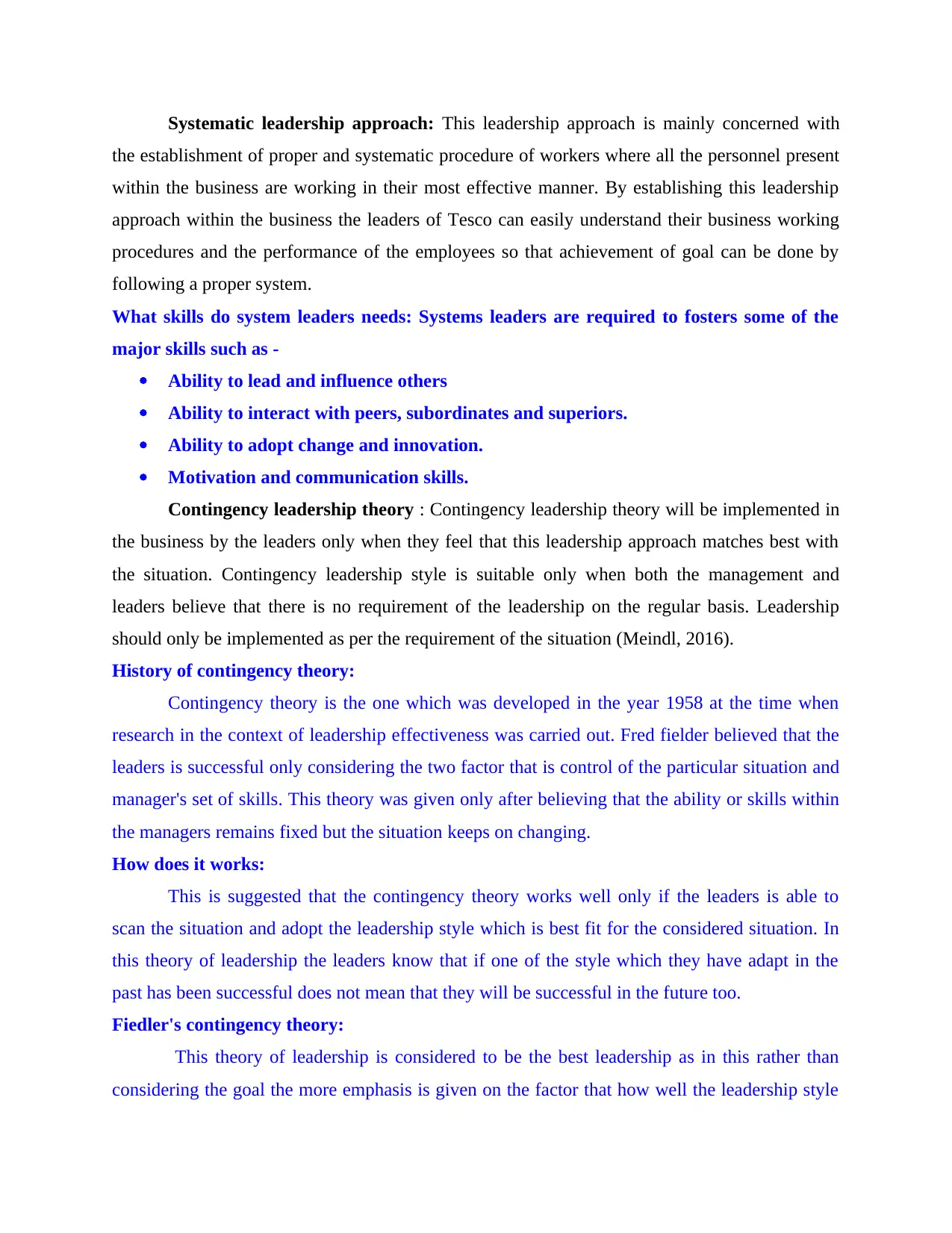
Systematic leadership approach: This leadership approach is mainly concerned with
the establishment of proper and systematic procedure of workers where all the personnel present
within the business are working in their most effective manner. By establishing this leadership
approach within the business the leaders of Tesco can easily understand their business working
procedures and the performance of the employees so that achievement of goal can be done by
following a proper system.
What skills do system leaders needs: Systems leaders are required to fosters some of the
major skills such as -
Ability to lead and influence others
Ability to interact with peers, subordinates and superiors.
Ability to adopt change and innovation.
Motivation and communication skills.
Contingency leadership theory : Contingency leadership theory will be implemented in
the business by the leaders only when they feel that this leadership approach matches best with
the situation. Contingency leadership style is suitable only when both the management and
leaders believe that there is no requirement of the leadership on the regular basis. Leadership
should only be implemented as per the requirement of the situation (Meindl, 2016).
History of contingency theory:
Contingency theory is the one which was developed in the year 1958 at the time when
research in the context of leadership effectiveness was carried out. Fred fielder believed that the
leaders is successful only considering the two factor that is control of the particular situation and
manager's set of skills. This theory was given only after believing that the ability or skills within
the managers remains fixed but the situation keeps on changing.
How does it works:
This is suggested that the contingency theory works well only if the leaders is able to
scan the situation and adopt the leadership style which is best fit for the considered situation. In
this theory of leadership the leaders know that if one of the style which they have adapt in the
past has been successful does not mean that they will be successful in the future too.
Fiedler's contingency theory:
This theory of leadership is considered to be the best leadership as in this rather than
considering the goal the more emphasis is given on the factor that how well the leadership style
the establishment of proper and systematic procedure of workers where all the personnel present
within the business are working in their most effective manner. By establishing this leadership
approach within the business the leaders of Tesco can easily understand their business working
procedures and the performance of the employees so that achievement of goal can be done by
following a proper system.
What skills do system leaders needs: Systems leaders are required to fosters some of the
major skills such as -
Ability to lead and influence others
Ability to interact with peers, subordinates and superiors.
Ability to adopt change and innovation.
Motivation and communication skills.
Contingency leadership theory : Contingency leadership theory will be implemented in
the business by the leaders only when they feel that this leadership approach matches best with
the situation. Contingency leadership style is suitable only when both the management and
leaders believe that there is no requirement of the leadership on the regular basis. Leadership
should only be implemented as per the requirement of the situation (Meindl, 2016).
History of contingency theory:
Contingency theory is the one which was developed in the year 1958 at the time when
research in the context of leadership effectiveness was carried out. Fred fielder believed that the
leaders is successful only considering the two factor that is control of the particular situation and
manager's set of skills. This theory was given only after believing that the ability or skills within
the managers remains fixed but the situation keeps on changing.
How does it works:
This is suggested that the contingency theory works well only if the leaders is able to
scan the situation and adopt the leadership style which is best fit for the considered situation. In
this theory of leadership the leaders know that if one of the style which they have adapt in the
past has been successful does not mean that they will be successful in the future too.
Fiedler's contingency theory:
This theory of leadership is considered to be the best leadership as in this rather than
considering the goal the more emphasis is given on the factor that how well the leadership style
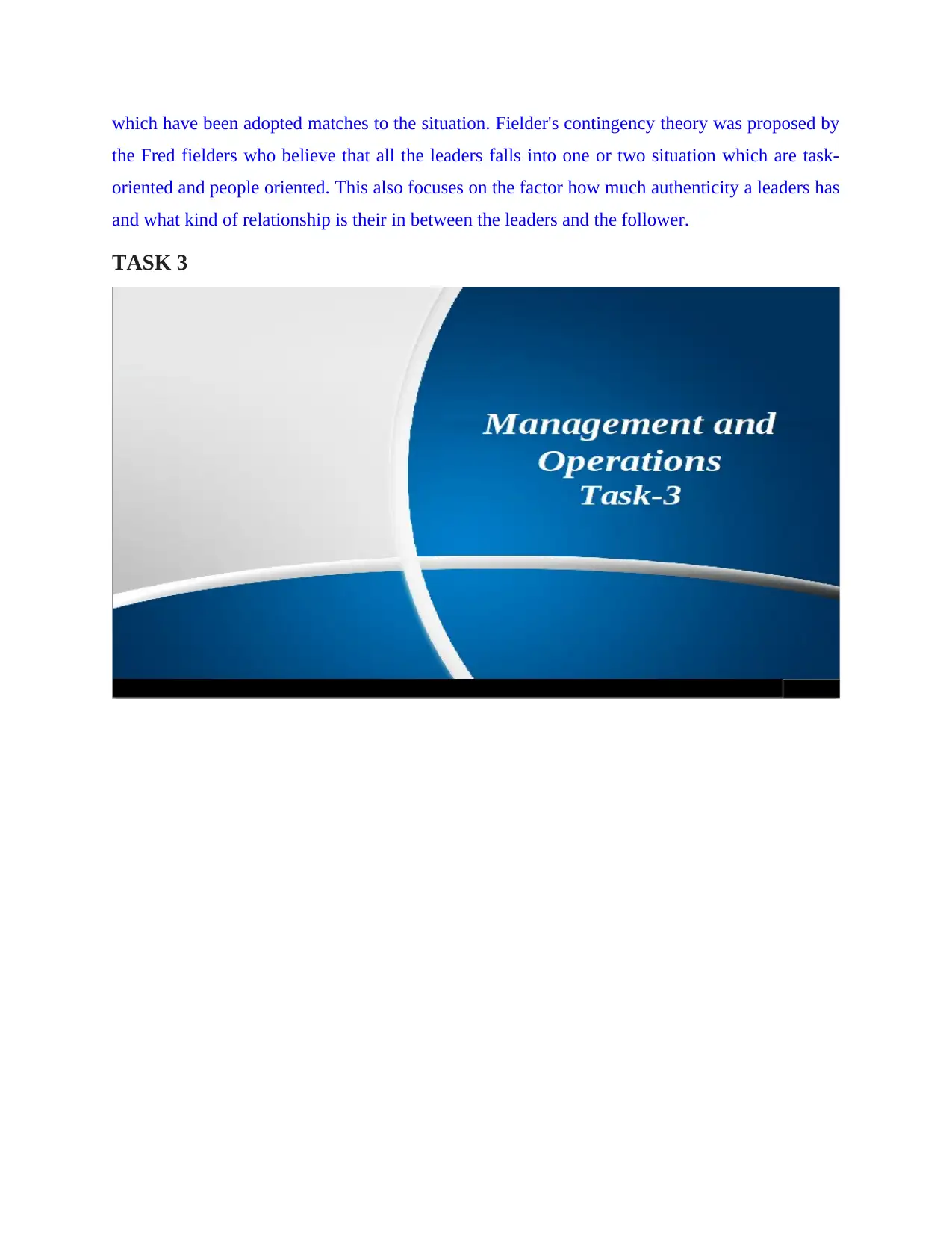
which have been adopted matches to the situation. Fielder's contingency theory was proposed by
the Fred fielders who believe that all the leaders falls into one or two situation which are task-
oriented and people oriented. This also focuses on the factor how much authenticity a leaders has
and what kind of relationship is their in between the leaders and the follower.
TASK 3
the Fred fielders who believe that all the leaders falls into one or two situation which are task-
oriented and people oriented. This also focuses on the factor how much authenticity a leaders has
and what kind of relationship is their in between the leaders and the follower.
TASK 3
⊘ This is a preview!⊘
Do you want full access?
Subscribe today to unlock all pages.

Trusted by 1+ million students worldwide

Paraphrase This Document
Need a fresh take? Get an instant paraphrase of this document with our AI Paraphraser
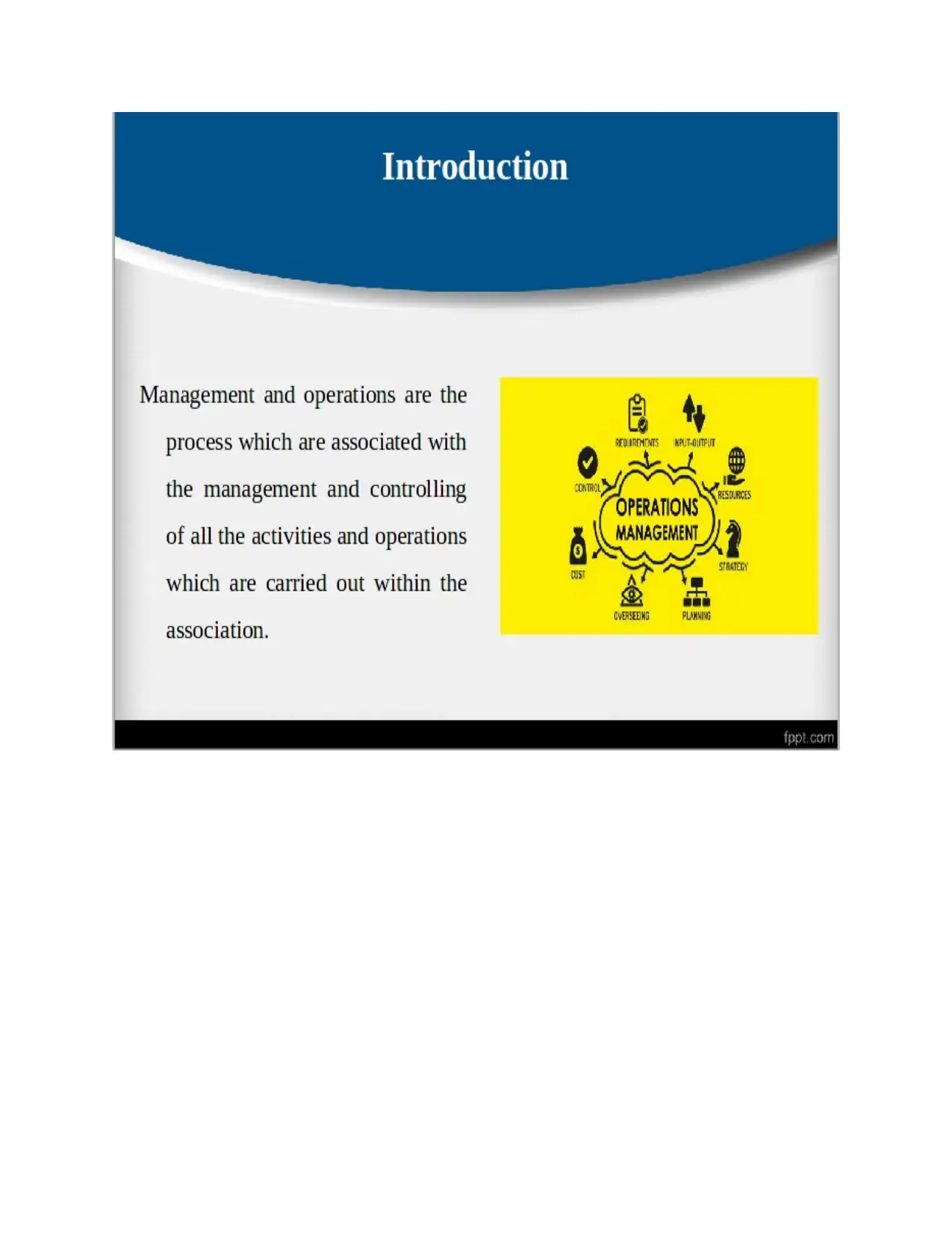
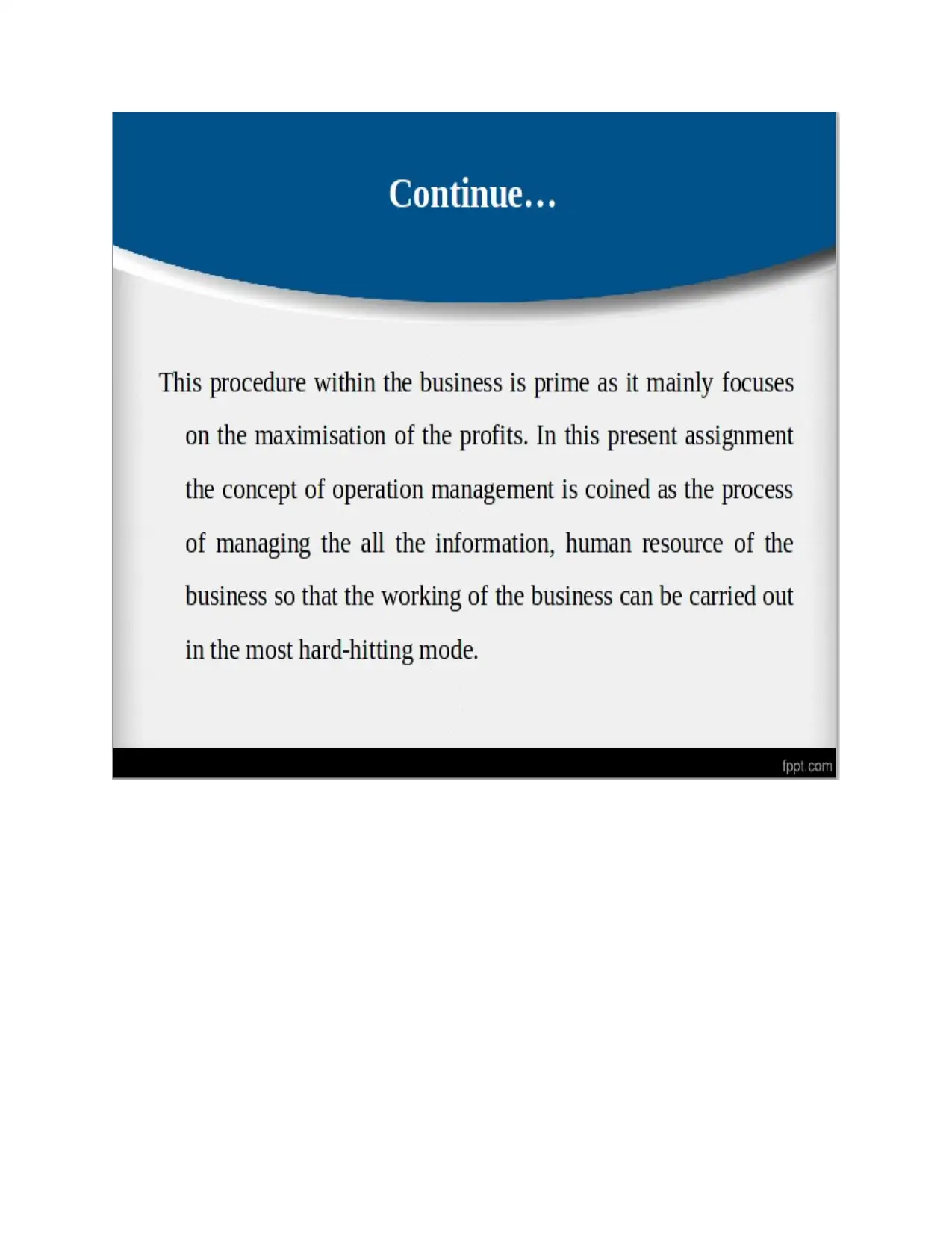
⊘ This is a preview!⊘
Do you want full access?
Subscribe today to unlock all pages.

Trusted by 1+ million students worldwide
1 out of 32
Related Documents
Your All-in-One AI-Powered Toolkit for Academic Success.
+13062052269
info@desklib.com
Available 24*7 on WhatsApp / Email
![[object Object]](/_next/static/media/star-bottom.7253800d.svg)
Unlock your academic potential
Copyright © 2020–2025 A2Z Services. All Rights Reserved. Developed and managed by ZUCOL.





